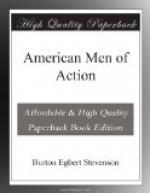Fort Walla-Walla belonged to the Hudson Bay Company, which had undisputed control of the rich Oregon fur trade, and which was determined to retain it at any cost. So the difficulties of the Oregon trail were invariably exaggerated, and immigration from the states systematically discouraged. Nevertheless, in the years following Whitman’s arrival, other parties of missionaries and settlers worked their way into the country, until, in 1842, their number reached about a hundred and fifty. The Hudson Bay Company realized that neither England nor America had a clear title to the region, and that its population must, in the end, determine its nationality. Consequently it bent every effort to hurry English settlers into the country. In October, 1842, Whitman was dining with a company of Englishmen at Walla-Walla, when a messenger arrived with news of the approach of a large body of settlers from Canada. A shout arose: “Hurrah for Oregon! America is too late! We’ve got the country!” And Whitman, at a glance, saw through the plan.
Twenty-four hours later, he had started to ride across the continent to carry the news to Washington. He had caught the import of the news, had grasped its consequences, and he was determined that Oregon, with its great forests and broad prairies, its mighty rivers, and its unparalleled richness, should be saved for the Union. If the Nation only knew the value of the prize, England would never be permitted to carry it off. His wife and friends protested against the desperate venture—four thousand miles on horseback—for it would soon be the dead of winter, with snow hiding the trail and filling the passes, with streams ice-blocked and winter-swollen, and last but not least, with the Blackfoot Indians on the warpath. But he would listen to none of this: his duty, as he conceived it, lay clear before him; he was determined to set out at once. Amos Lovejoy volunteered to accompany him, a busy night was spent in preparation, and the next day they were off.
No diary of that remarkable journey was kept by Dr. Whitman, but most of its incidents are known. Terribly severe weather was encountered almost at the start, for ten days they were snowed up in the mountains, and long before the journey ended, were reduced to rations of dog and mule meat. But they struggled on, more than once losing the way and giving themselves up for lost, and on March 3, 1843, just five months from Walla-Walla, Whitman entered Washington.
His spectacular ride rivetted public attention upon the far western country, and the information which he gave concerning it opened the Nation’s eyes to its value. When he returned, later in the year, to the banks of the Columbia, he took back with him a train of two hundred wagons and a thousand settlers—a veritable army of occupation which the British could not match. Three years later, so steadily did the tide continue which Whitman had started, the American population had risen to over ten thousand, there was never any further real uncertainty as to whom Oregon belonged, and the treaty of 1846 settled the question for all time.




